Table of Contents
Plants vocabulary refers to the words used to describe different parts of plants, how they grow, and how they reproduce. It covers basic terms about plant structures, how plants make food, and their environment.
Knowing plants vocabulary helps in understanding nature, gardening, farming, and the environment better.
List of Plants Names
- Tree
- Leaf
- Stem
- Root
- Branch
- Bark
- Seed
- Bud
- Thorn
- Grass
- Shrub
- Bush
- Vine
- Fern
- Moss
- Cactus
- Pine
- Oak
- Maple
- Palm
- Willow
- Herb
- Weed
- Sapling
- Trunk
- Twig
- Pollen
- Nectar
- Fruit
- Vegetable
- Evergreen
- Deciduous
- Bamboo
- Aloe
- Ivy
- Clover
- Pineapple Plant
- Coconut Tree
- Banana Tree
- Apple Tree
- Olive Tree
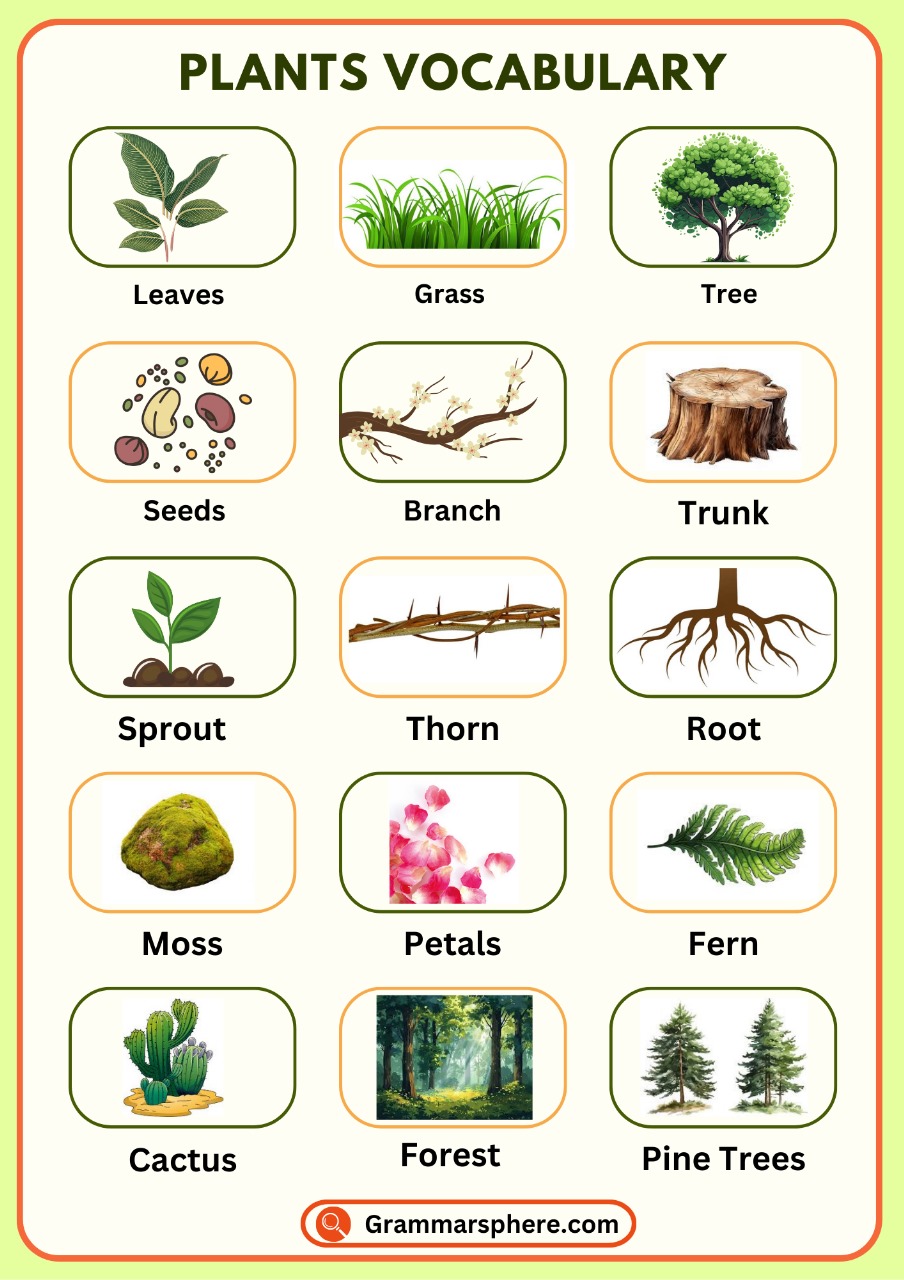
Plants Vocabulary with Description
| Plant Term | Description |
|---|---|
| Tree | A tall plant with a trunk, branches, and leaves. |
| Leaf | The green, flat part of a plant that grows from branches or stems. |
| Stem | The main part of a plant that supports leaves, flowers, or fruits. |
| Root | The part of a plant that grows underground and absorbs water and nutrients. |
| Branch | A part of a tree that grows out from the trunk. |
| Bark | The hard, outer covering of a tree trunk or branch. |
| Seed | A small part of a plant that can grow into a new plant. |
| Bud | A small part of a plant that can grow into a flower, leaf, or branch. |
| Thorn | A sharp, pointed part on some plants, like roses. |
| Grass | A green plant with thin leaves that covers the ground. |
| Shrub | A small to medium-sized plant with many stems, like a bush. |
| Bush | A thick, low-growing plant with many branches. |
| Vine | A plant that climbs or spreads along the ground, like grapes. |
| Fern | A green plant with feathery leaves, often found in shady areas. |
| Moss | A soft, green plant that grows in damp or shady places. |
| Cactus | A desert plant with thick stems and spines, storing water. |
| Pine | A type of tree with needle-like leaves and cones. |
| Oak | A strong tree with large branches and acorns. |
| Maple | A tree with broad leaves, known for its colorful fall leaves and syrup. |
| Palm | A tropical tree with long, feather-like leaves and no branches. |
| Willow | A tree with long, drooping branches, often found near water. |
| Herb | A small plant used for cooking, medicine, or fragrance. |
| Weed | An unwanted plant that grows where it’s not needed. |
| Sapling | A young, small tree. |
| Trunk | The thick, main stem of a tree. |
| Twig | A small, thin branch of a tree or plant. |
| Pollen | A fine powder produced by plants, used for reproduction. |
| Nectar | A sweet liquid made by flowers, which attracts bees and butterflies. |
| Fruit | The part of a plant that contains seeds and is often edible. |
| Vegetable | An edible part of a plant, like leaves, roots, or stems. |
| Evergreen | A plant or tree that stays green all year round. |
| Deciduous | A plant or tree that loses its leaves in the fall. |
| Bamboo | A tall, fast-growing plant with hollow stems, used for building or decoration. |
| Aloe | A plant with thick, spiky leaves, often used for skin care. |
| Ivy | A climbing plant with green leaves, often seen on walls or trees. |
| Clover | A small plant with three-part leaves, often found in grass. |
| Pineapple Plant | A tropical plant with spiky leaves that grows pineapples. |
| Coconut Tree | A tall palm tree that grows coconuts. |
| Banana Tree | A tropical plant with large leaves that grows bananas. |
| Apple Tree | A tree that grows apples. |
| Olive Tree | A tree that grows olives, used for oil and food. |
Plant Parts
Roots: Anchor the plant and absorb water/nutrients.
- Fibrous root
- Taproot
- Root hairs
Stem: Supports the plant and transports nutrients.
- Trunk (in trees)
- Stipe (in ferns)
- Node (where leaves or branches emerge)
- Internode (the space between nodes)
Leaves: The main site for photosynthesis.
- Blade
- Petiole (leaf stalk)
- Veins
- Leaf margin (smooth, serrated, lobed)
- Stomata (pores for gas exchange)
Flowers: Reproductive structures.
- Petals
- Sepals
- Stamens (male, with anthers and filaments)
- Pistil (female, including stigma, style, and ovary)
- Ovules (future seeds)
Fruit: The mature ovary containing seeds.
- Drupe (e.g., peach)
- Berry (e.g., tomato)
- Pome (e.g., apple)
- Capsule
- Nut
Seeds: Contain the embryo of a plant.
- Seed coat
- Cotyledon (seed leaves)
- Embryo
- Endosperm (nutrient store)
Plant Types
Herbaceous plants: Non-woody, soft stems.
- Annuals: Live for one growing season (e.g., petunias)
- Perennials: Live for multiple years (e.g., lavender)
- Biennials: Live for two years (e.g., parsley)
Woody plants: Have hard stems, often in the form of shrubs or trees.
- Trees: Tall, single-trunked plants (e.g., oak)
- Shrubs: Woody plants with multiple stems (e.g., azalea)
- Vines: Woody or herbaceous plants that climb or sprawl (e.g., ivy)
Aquatic plants: Grow in water.
- Emergent plants (e.g., cattails)
- Floating plants (e.g., water lilies)
- Submerged plants (e.g., eelgrass)
Succulents: Store water in their leaves
Idioms Related to Plants
1. Take root
To become established or accepted.
- Her new business idea is finally taking root in the community.
2. Grow like a weed
To grow or increase very quickly.
- The new company is growing like a weed; it seems like they’re expanding every week.
3. Hit the ground running
To start something and proceed at a fast pace with energy and enthusiasm.
- When she started her new job, she hit the ground running, already making important changes in the first week.
4. A blossom (flower) out
To develop and improve, often after a slow start.
- Over the past few months, his talent really blossomed out, and now he’s leading the project.
5. Let the grass grow under one’s feet
To waste time or not take action.
- We can’t let the grass grow under our feet; we need to start the project as soon as possible.
6. Put down roots
To settle in one place and establish a home or business.
- After traveling the world for years, they finally decided to put down roots in a small town.
7. A thorn in someone’s side
A constant source of annoyance or trouble.
- The noisy neighbors have become a real thorn in my side.
8. Nip it in the bud
To stop something at an early stage, before it grows or becomes a problem.
- We need to nip this issue in the bud before it becomes a major conflict.
9. In full bloom
To be at the peak of beauty or development.
- The garden is in full bloom, with vibrant flowers everywhere.
10. Reap what you sow
To experience the consequences of your actions, whether good or bad.
- You’ve worked hard this year, and now you’re reaping what you sow with that promotion.
FAQS
What are key terms related to plant life?
Key terms include germination, photosynthesis, pollination, fertilization, growth, dormancy, seed dispersal, and vegetative propagation. Other important terms are maturation, senescence, sapling, tropism, bud, evergreen, and deciduous.”
What is the vocabulary of flora?
The vocabulary of flora includes terms like species (types of plants), genus (related plant groups), flora (plant life in an area), biodiversity (variety of plant life), habitat (plant environment), endemic (native plants), wildflowers (non-cultivated flowers), deciduous (plants that shed leaves), evergreen (plants with year-round leaves), herbaceous (soft-stemmed plants), and woody (hard-stemmed plants).
What is the meaning of plant in vocabulary?
In vocabulary, plant refers to a living organism that typically grows in soil, absorbs water and nutrients, and produces its own food through photosynthesis. It can also refer to the seedling, flowering parts, or vegetation of a specific area. Additionally, plant can mean a factory or industrial establishment.
You May Also Like

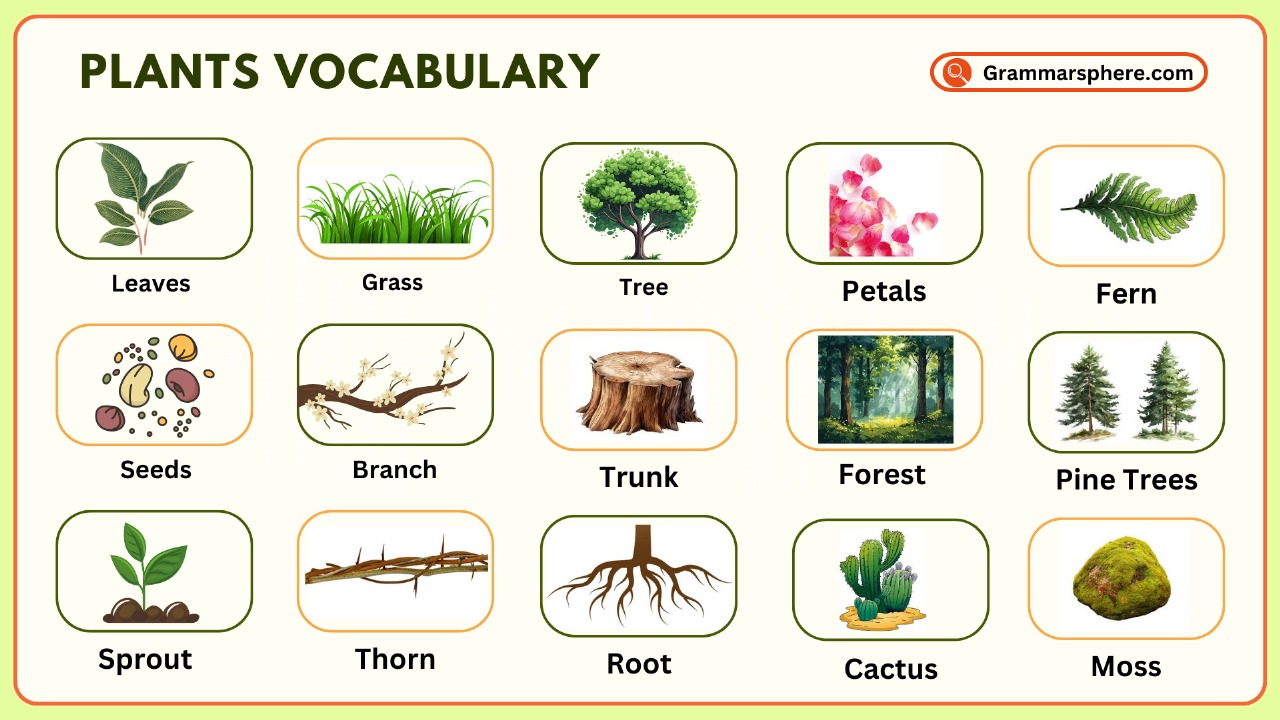
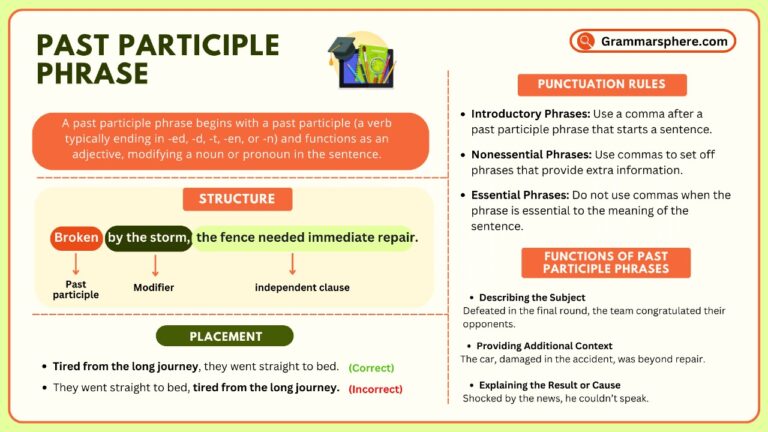
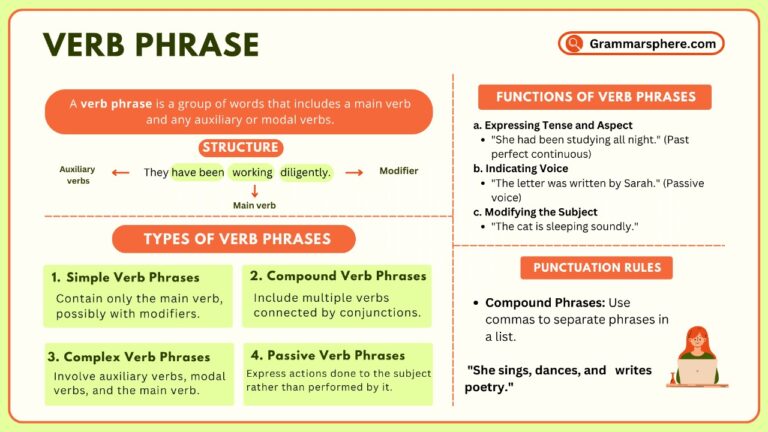
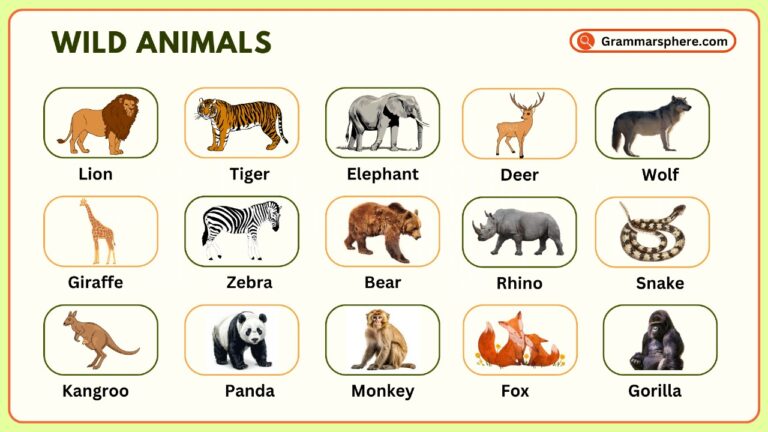
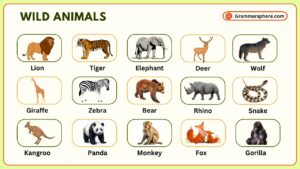
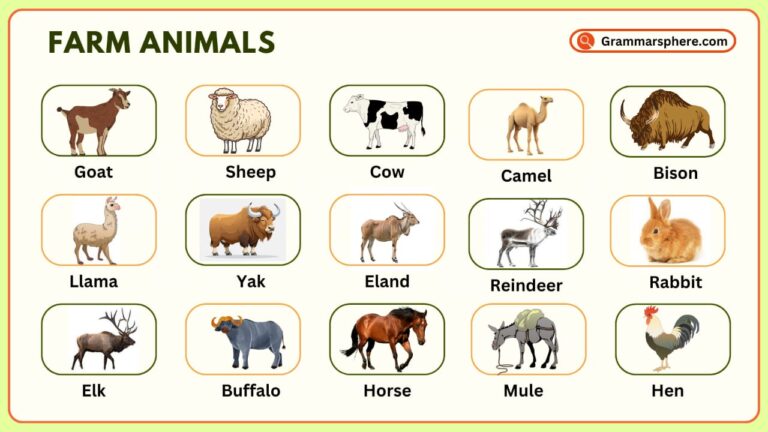
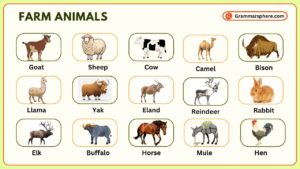
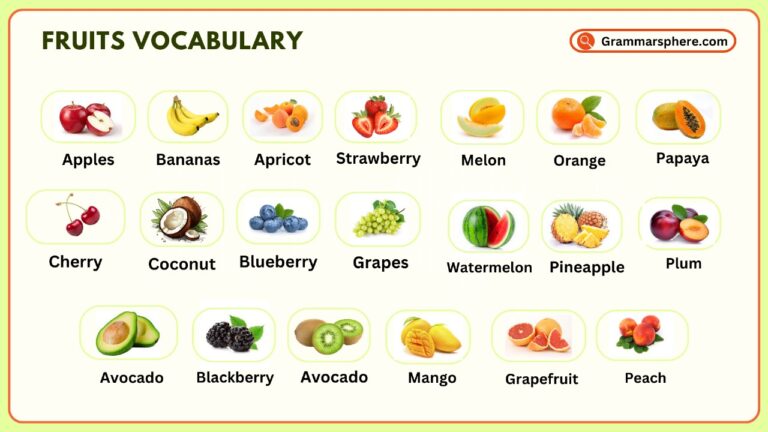
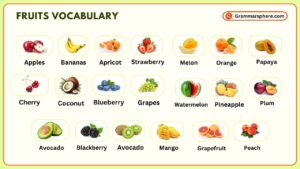
Leave a Comment